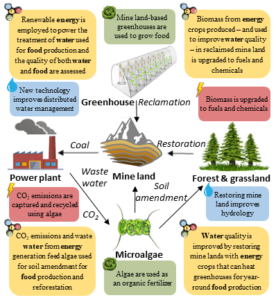Research
Among the issues facing humankind, providing adequate amounts of food to a growing population, developing CO2-neutral sustainable sources of energy, and managing water resources represent three key challenges. The critical need for a workforce trained to meet these will be addressed by this NRT, with a focus on solving problems inherent to Appalachia. This will be achieved by integrating the training with a raft of new research initiatives at UK that will address Appalachian development (see Figure 1), and more specifically, the use of reclaimed mine land to drive economic development in the region. Initiatives will target four areas essential to this goal: 1) the restoration of mine land in eastern Kentucky by re-forestation to improve hydrology, water quality, and provide a source of biomass; 2) the use of restored mine land for year-round food production, requiring localized water treatment powered by renewable energy; 3) the use of algae to treat CO2 emissions and waste water from energy production to yield a high quality fertilizer for soil improvement in reclaimed mine land areas; and 4) upgrading of biomass produced on reclaimed mine land – including lignin, an underutilized component of lignocellulosic biomass – to chemicals and fuels. Common to them will be the use of techno-economic analysis (TEA) and lifecycle assessment (LCA) to analyze experimental data from the perspective of economic and environmental feasibility. In this way research bottlenecks will be identified and the most promising routes to mine land reclamation and utilization will be identified.
By way of background, the Appalachian Region consists of 13 states stretching from New York to Mississippi, encompassing ~20% of the U.S. population [1]. Appalachia was once dominated by mining, forestry, agricultural and chemical industries; however, over the last decades this landscape has changed, the poverty rate of the region being brought down by the diversification of the economy. Although the poverty rate fell to 17.1% for the period from 2011-2015, it is still above the U.S. rate of 15.5% for the same period. Unemployment in Appalachia is also higher than in the U.S. overall, Kentucky having the highest unemployment rate in the region. According to the Appalachian Regional Commission (ARC), of the 420 counties that make up the region, 199 (47%) of them fall into the “At-Risk” (115) and “Distressed” (84) categories for 2017 [2]. The majority of these “distressed” counties – meaning that they are in the bottom 10% of the nation’s most economically depressed counties – can be found in Eastern Kentucky. This is exacerbated by the fact that the coal mining industry in these counties is in serious decline, associated employment numbers having dropped considerably [3,4]. For example, coal employment in Eastern Kentucky averaged 3,896 in 2017 compared to 13,679 in 2011 [4].
Two critical resources in the region are a population in search of new job opportunities and vast tracts of land that can be utilized for a range of economic activities. It has been reported that albeit the Abandoned Mine Land Program has already reclaimed over 800,000 acres of land and water across the country, there are still another 6.2 million acres that need to be reclaimed [5]. In Kentucky alone, there are currently 246,311 acres of permitted land that could be utilized in the continued diversification and development of these depressed economies [6]. Some critical limitations of reclaimed mine land are its typical dearth of organic matter, high/low soil pH levels, contaminated water, heavy metals in the soil, labor availability, and transportation challenges. Proposed solutions to these challenges must be economical and sustainable if these distressed counties are to raise their economies out of the bottom 10% of counties in the U.S. Therefore, the specific research objective of this NRT is to evaluate the economic feasibility and sustainability of the solutions proposed to turn reclaimed mine lands into an economic engine for this region. Although there is statewide recognition of the need for Appalachian economic development based on the best use of available resources, an evaluation of the extent to which reclaimed mine land can contribute to regional development – and specifically, how it can be most viably employed for this purpose – is lacking.
Economics and sustainability assessments will rely on simulation, mathematical programming, and life cycle analysis (LCA) methodologies. Development of models for this region allows for the investigation of the economic feasibility of a solution in a proactive setting before scarce monetary resources are invested only to find it is not economically feasible. For example, NRT participants will collaborate to develop a simulation model to investigate the application of microalgae biofertilizers versus conventional fertilizers to improve soil quality and the utilization of reclaimed mine land for the placement of greenhouses for cultivation of locally produced food. Models of this type will provide an invaluable feedback loop to guide the work of the NRT participants and other regional economic development groups. It also forges an increased level of interdisciplinary integration to ensure the models are valid. Moreover, this approach will provide mathematical programming models that can be used to evaluate the current transportation network and the optimal mix of solutions that could be employed at the parcel, county, or region levels. Lastly, LCA modeling will be used to assess the long-term sustainability of all solutions and provide guidance on critical areas that need additional work to make the solutions sustainable.
References
- https://www.arc.gov/ (accessed February 2019).
- County Economic Status in Appalachia, Fiscal year 2018. Appalachian Regional Commission, 2017. https://www.arc.gov/assets/maps/related/County-Economic-Status_FY2018_Map.pdf.
- http://www.kentucky.com/news/state/article75087302.html (accessed February 2019).
- http://www.kentucky.com/news/state/article182371386.html (accessed February 2019).
- Dixon, E. L.; Bilbrey, K. Abandoned Mine Land Program: A Policy Analysis for Central Appalachia and the Nation. 2015. https://s3.amazonaws.com/academia.edu.documents/38133317/AML_POLICY_ANALYSIS.pdf?AWSAccessKeyId=AKIAIWOWYYGZ2Y53UL3A&Expires=1516568967&Signature=uiNI1nR0j0fCH8bbe0CSleiArhs%3D&response-content-disposition=inline%3B%20filename%3DAbandoned_Mine_Land_Program_A_Policy_Ana.pdf.
- https://www.arcc.osmre.gov/about/states/ky.shtm (accessed February 2019).

